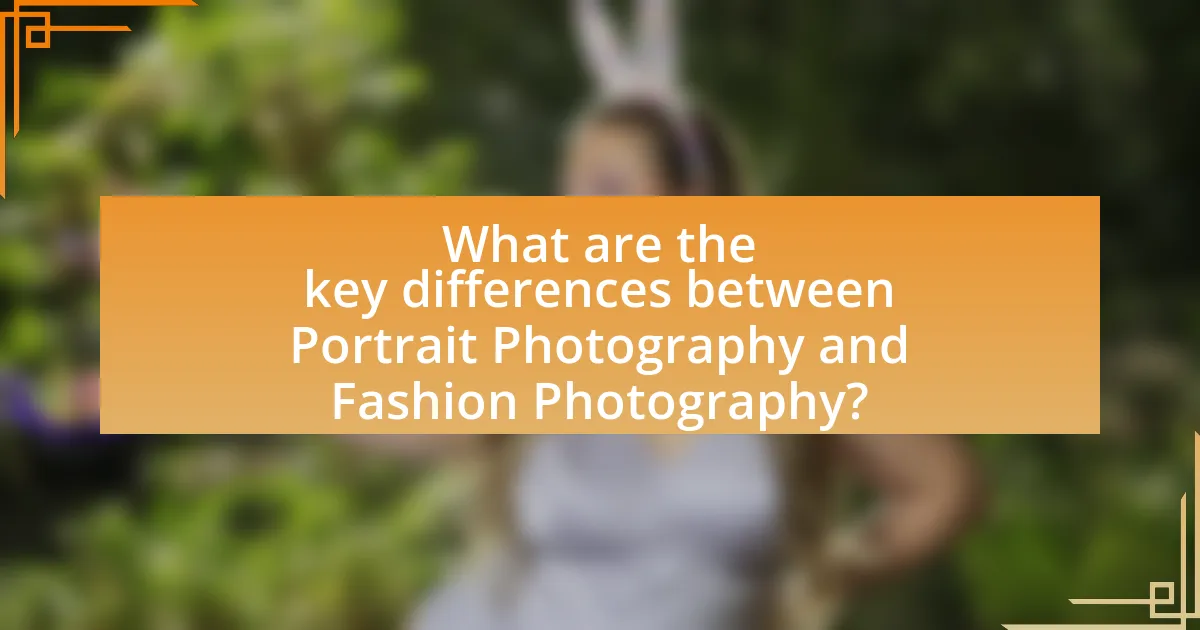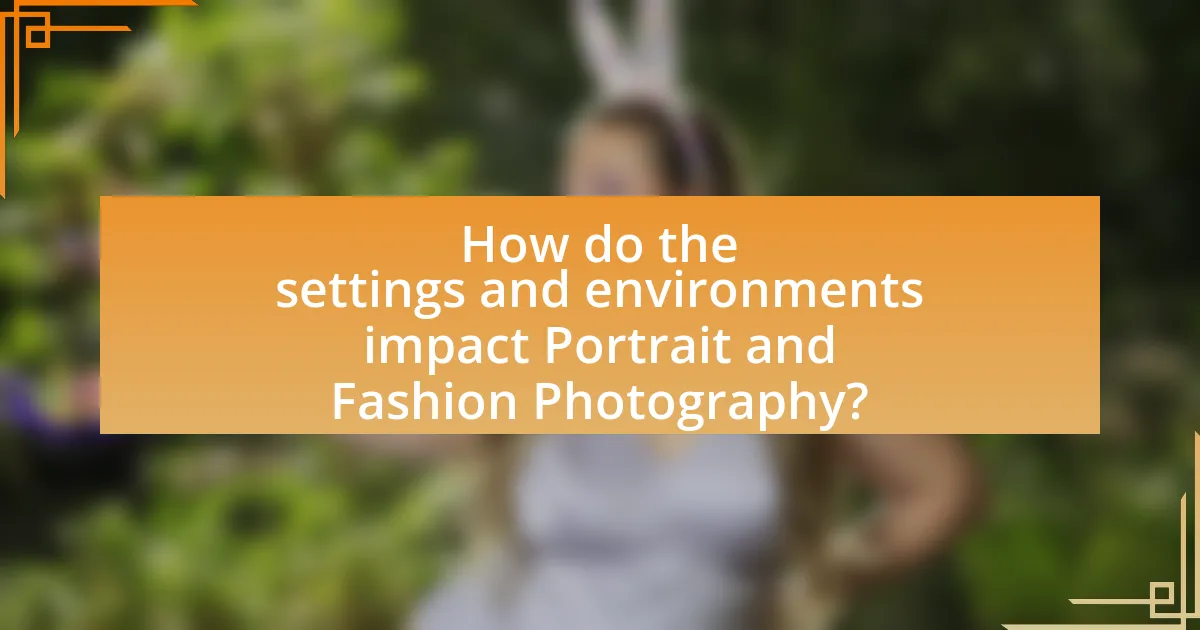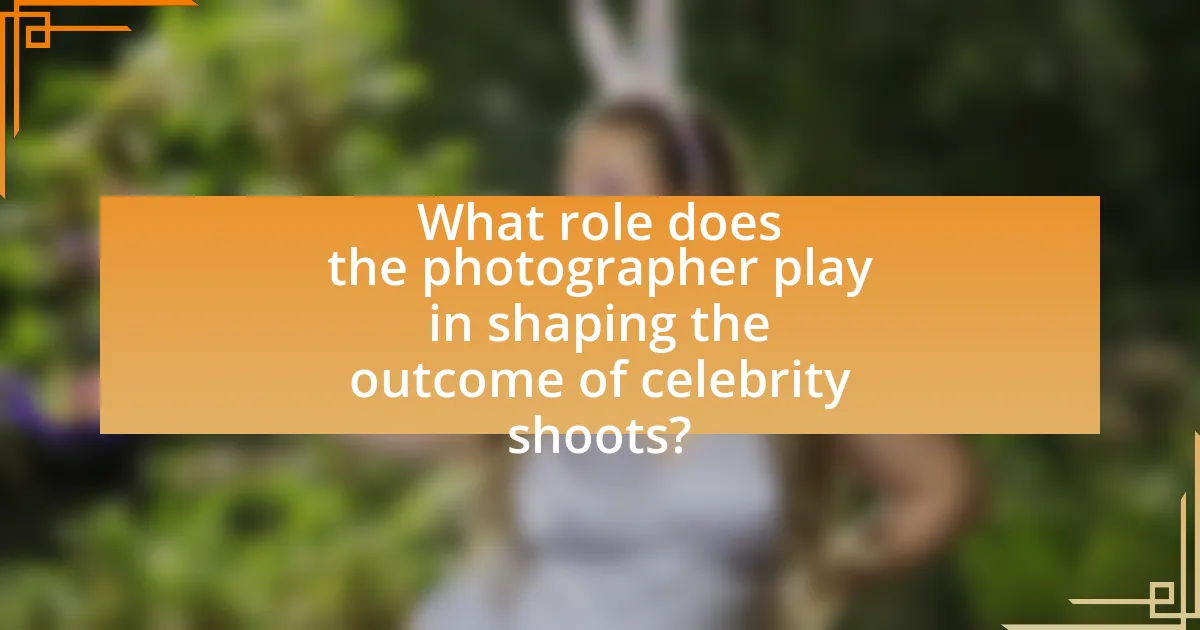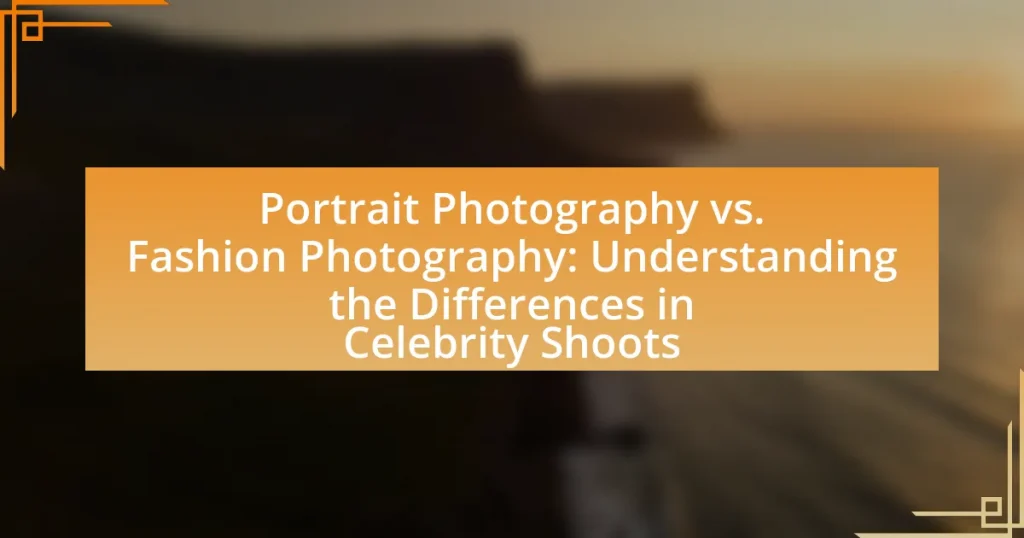The article examines the key differences between portrait photography and fashion photography, particularly in the context of celebrity shoots. It outlines how portrait photography emphasizes capturing the personality and emotions of individuals, while fashion photography focuses on showcasing clothing and accessories in a stylized manner. The article discusses the distinct objectives, techniques, and settings used in each genre, highlighting the role of the photographer in shaping the visual narrative. Additionally, it addresses common misconceptions and provides practical tips for photographers transitioning between these two styles.

What are the key differences between Portrait Photography and Fashion Photography?
Portrait photography focuses on capturing the personality and mood of an individual or group, emphasizing facial expressions and emotions, while fashion photography aims to showcase clothing and accessories, often in a stylized manner that highlights trends and brands. In portrait photography, the subject is typically the main focus, with the background and lighting designed to enhance their features. In contrast, fashion photography often incorporates elaborate settings and poses to create a narrative around the fashion items being displayed. This distinction is evident in the techniques used; portrait photographers prioritize natural expressions and intimate settings, whereas fashion photographers utilize dramatic lighting and stylized compositions to create visually striking images that promote fashion.
How do the objectives of Portrait Photography differ from those of Fashion Photography?
The objectives of Portrait Photography focus on capturing the personality and essence of an individual, while Fashion Photography aims to showcase clothing and accessories in a visually appealing manner. Portrait Photography seeks to create a connection between the subject and the viewer, often emphasizing emotions and character, as seen in classic works by photographers like Annie Leibovitz. In contrast, Fashion Photography prioritizes the presentation of fashion items, often using stylized settings and models to highlight trends, as exemplified by the editorial work in magazines like Vogue.
What is the primary focus of Portrait Photography in celebrity shoots?
The primary focus of Portrait Photography in celebrity shoots is to capture the personality and essence of the subject. This type of photography emphasizes the subject’s facial expressions, emotions, and character, often using lighting and composition to highlight their unique features. Unlike fashion photography, which prioritizes clothing and styling, portrait photography aims to create a connection between the viewer and the subject, showcasing their individuality and story.
How does Fashion Photography emphasize clothing and style in celebrity shoots?
Fashion photography emphasizes clothing and style in celebrity shoots by focusing on the garments’ details, textures, and overall aesthetic appeal. This genre utilizes specific lighting, angles, and compositions to highlight the fashion elements, ensuring that the clothing becomes the focal point of the image. For instance, high-contrast lighting can accentuate fabric textures, while dynamic poses can showcase the flow and fit of garments. Additionally, fashion photography often incorporates styling choices, such as accessories and makeup, to create a cohesive look that enhances the overall presentation of the clothing. This approach is validated by the fact that renowned fashion magazines like Vogue and Harper’s Bazaar prioritize such techniques to attract viewers and convey the latest trends effectively.
What techniques are commonly used in Portrait Photography compared to Fashion Photography?
Portrait photography primarily focuses on capturing the personality and mood of an individual, often utilizing techniques such as natural lighting, shallow depth of field, and direct engagement with the subject to evoke emotion. In contrast, fashion photography emphasizes the clothing and accessories, employing techniques like dramatic lighting, dynamic poses, and stylized settings to highlight the fashion items.
For instance, portrait photographers often use soft, diffused lighting to create a flattering effect on the subject’s face, while fashion photographers may use harsh lighting to create striking contrasts that enhance the garments. Additionally, portrait photography typically involves closer framing to emphasize facial expressions, whereas fashion photography often incorporates wider shots to showcase the full outfit and its context within a scene.
What lighting techniques are preferred in Portrait Photography?
The preferred lighting techniques in portrait photography include natural light, softbox lighting, and Rembrandt lighting. Natural light is favored for its ability to create soft, flattering images, often used during golden hour for optimal results. Softbox lighting provides controlled, diffused light that minimizes harsh shadows, making it ideal for studio settings. Rembrandt lighting, characterized by a triangle of light on the subject’s cheek, adds depth and dimension, enhancing facial features. These techniques are widely recognized for their effectiveness in producing high-quality portraits that highlight the subject’s personality and characteristics.
How does the use of props differ between Portrait and Fashion Photography?
In Portrait Photography, props are typically used to enhance the subject’s personality and create a more intimate connection, often focusing on personal items that reflect the individual’s character. In contrast, Fashion Photography employs props primarily to complement the clothing and accessories, emphasizing style and trends rather than personal narrative. This distinction is evident as Portrait Photography aims to capture the essence of the subject, while Fashion Photography seeks to showcase the fashion itself, often using props that create a specific aesthetic or thematic context.

How do the settings and environments impact Portrait and Fashion Photography?
Settings and environments significantly impact both portrait and fashion photography by influencing the mood, style, and narrative of the images. In portrait photography, the setting often reflects the subject’s personality and background, enhancing emotional connection; for instance, a natural outdoor setting can evoke warmth and authenticity, while a studio backdrop can create a more controlled and polished look. In contrast, fashion photography relies heavily on environments to showcase clothing and accessories, where dynamic settings—such as urban landscapes or exotic locations—can amplify the visual appeal and context of the fashion being presented. Research indicates that environments can alter viewer perception, with studies showing that images taken in vibrant, engaging settings are more likely to attract attention and convey a sense of lifestyle associated with the fashion brand.
What types of locations are typically chosen for Portrait Photography?
Portrait photography typically utilizes locations that enhance the subject’s personality and story. Commonly chosen locations include natural settings like parks and gardens, urban environments featuring interesting architecture, and indoor spaces such as studios or homes that provide a controlled atmosphere. These settings are selected to create a specific mood or context that complements the subject, allowing for a more engaging and visually appealing portrait.
How does the choice of background enhance the subject in Portrait Photography?
The choice of background in portrait photography significantly enhances the subject by providing context and emotional depth. A well-selected background can complement the subject’s features, draw attention to them, and convey the intended mood or narrative of the photograph. For instance, a soft, blurred background can isolate the subject, emphasizing their expression and personality, while a textured or colorful background can add layers of meaning and interest, enriching the overall composition. Studies in visual perception indicate that backgrounds influence how viewers interpret subjects, reinforcing the importance of thoughtful background selection in achieving impactful portraits.
What environments are favored for Fashion Photography shoots?
Fashion photography shoots are favored in environments that enhance the aesthetic appeal of clothing and accessories. Commonly preferred settings include urban landscapes, studios with controlled lighting, and natural outdoor locations that provide dynamic backdrops. Urban environments offer architectural elements and vibrant street scenes, while studios allow for precise lighting control and creative setups. Natural settings, such as beaches or forests, add organic beauty and context to the fashion being showcased. These environments are chosen to complement the fashion narrative and engage the viewer effectively.
How do urban settings influence the style of Fashion Photography?
Urban settings significantly influence the style of fashion photography by providing dynamic backdrops that enhance the visual narrative of the clothing and accessories being showcased. The architecture, street art, and diverse cultural elements found in urban environments create a vibrant context that can reflect current trends and societal themes, making the fashion imagery more relatable and impactful. For instance, the use of gritty textures and urban landscapes can evoke a sense of edginess and modernity, aligning with contemporary fashion movements. Additionally, studies have shown that urban locations often attract a more diverse audience, which can lead to a broader appeal for fashion brands, as seen in campaigns shot in cities like New York and Tokyo, where the urban aesthetic is integral to the fashion identity.

What role does the photographer play in shaping the outcome of celebrity shoots?
The photographer plays a crucial role in shaping the outcome of celebrity shoots by influencing the visual narrative and emotional impact of the images. Their expertise in lighting, composition, and direction directly affects how the celebrity is portrayed, which can enhance or alter public perception. For instance, a photographer’s choice of angles and settings can evoke specific moods, making the images resonate more with audiences. Additionally, the photographer’s ability to connect with the subject can lead to more authentic expressions, resulting in compelling photographs that capture the essence of the celebrity. This is evident in high-profile shoots where renowned photographers like Annie Leibovitz have created iconic images that define a celebrity’s public persona.
How does the photographer’s vision differ between Portrait and Fashion Photography?
The photographer’s vision in Portrait Photography focuses on capturing the subject’s personality and emotions, while in Fashion Photography, the vision emphasizes showcasing clothing and style within a creative context. In Portrait Photography, the goal is to create a connection between the subject and the viewer, often using natural light and intimate settings to highlight the individual’s character. In contrast, Fashion Photography often employs elaborate setups, dramatic lighting, and stylized poses to present garments in a visually striking manner, aiming to evoke a specific mood or trend. This distinction is evident in the techniques and approaches used, where Portrait Photography prioritizes authenticity and emotional depth, whereas Fashion Photography prioritizes aesthetic appeal and commercial viability.
What skills are essential for a photographer specializing in Portrait Photography?
Essential skills for a photographer specializing in Portrait Photography include strong interpersonal communication, technical proficiency in camera settings, and an understanding of lighting techniques. Interpersonal communication is crucial as it helps the photographer establish rapport with subjects, making them feel comfortable and allowing for more authentic expressions. Technical proficiency ensures that the photographer can effectively manipulate settings such as aperture, shutter speed, and ISO to achieve desired effects. Additionally, a solid understanding of lighting techniques, including natural and artificial light, is vital for creating flattering and dynamic portraits. These skills collectively enable the photographer to capture compelling and engaging images that resonate with viewers.
What unique challenges do Fashion Photographers face during celebrity shoots?
Fashion photographers face unique challenges during celebrity shoots, primarily due to the high expectations for both aesthetics and the celebrity’s public image. These photographers must navigate tight schedules, as celebrities often have limited availability, which can lead to time constraints that affect the shoot’s quality. Additionally, managing the celebrity’s comfort and mood is crucial, as any discomfort can impact the final images.
Moreover, fashion photographers must contend with the pressure of creating visually striking images that align with the latest trends while also satisfying the demands of brands and magazines. This often requires a deep understanding of both the fashion industry and the celebrity’s personal style. The presence of publicists and managers can also complicate the creative process, as they may impose restrictions on poses or settings, limiting the photographer’s artistic freedom.
These challenges are compounded by the need for quick turnaround times for edited images, as media outlets often require immediate content for publication. Thus, the combination of time constraints, the need for artistic collaboration, and the influence of external parties creates a complex environment for fashion photographers during celebrity shoots.
What are the best practices for capturing compelling celebrity portraits?
The best practices for capturing compelling celebrity portraits include establishing a connection with the subject, utilizing natural light, and focusing on composition. Establishing a rapport with the celebrity can lead to more authentic expressions, enhancing the emotional impact of the portrait. Natural light is often preferred as it creates a soft, flattering effect, which is crucial for highlighting the subject’s features. Additionally, careful attention to composition, such as the rule of thirds and framing, can significantly improve the visual appeal of the portrait. These practices are supported by professional photographers who emphasize the importance of these elements in creating striking images that resonate with viewers.
How can photographers effectively communicate with their celebrity subjects?
Photographers can effectively communicate with their celebrity subjects by establishing a rapport and using clear, respectful language. Building trust is essential, as celebrities often have specific concerns about their image and privacy. Photographers should actively listen to their subjects’ preferences and feedback during the shoot, ensuring that the celebrity feels comfortable and valued. Research indicates that effective communication enhances collaboration and results in better photographic outcomes, as seen in studies on interpersonal dynamics in creative fields.
What tips can enhance the storytelling aspect of Portrait Photography?
To enhance the storytelling aspect of portrait photography, photographers should focus on capturing genuine emotions and expressions. This can be achieved by creating a comfortable environment for the subject, allowing them to relax and express their true selves. Additionally, incorporating meaningful props or backgrounds that relate to the subject’s story can add depth and context to the image. Using natural light can also enhance the mood and atmosphere, making the portrait more engaging. Research indicates that portraits that evoke emotion tend to resonate more with viewers, as demonstrated in studies on visual storytelling in photography.
What are the common misconceptions about Portrait and Fashion Photography?
Common misconceptions about portrait and fashion photography include the belief that both styles are interchangeable and that they serve the same purpose. Portrait photography primarily focuses on capturing the personality and mood of an individual, often emphasizing emotional expression, while fashion photography is geared towards showcasing clothing and accessories, often in a stylized manner. Additionally, many people think that portrait photography requires less technical skill than fashion photography; however, both genres demand a high level of expertise in lighting, composition, and posing. Furthermore, there is a misconception that fashion photography is solely about glamour and beauty, neglecting the artistic and narrative elements that can be present in both styles.
How can understanding these misconceptions improve a photographer’s work?
Understanding misconceptions about portrait and fashion photography can significantly enhance a photographer’s work by enabling them to tailor their techniques and approaches to suit the specific demands of each genre. For instance, recognizing that portrait photography focuses on capturing the subject’s personality and emotions, while fashion photography emphasizes clothing and styling, allows photographers to adjust their lighting, composition, and direction accordingly. This differentiation leads to more impactful images that resonate with the intended audience. Studies show that photographers who adapt their methods based on genre-specific misconceptions produce higher-quality work, as they align their creative vision with the expectations of clients and viewers.
What practical tips can photographers apply when transitioning between Portrait and Fashion Photography?
Photographers transitioning between Portrait and Fashion Photography should focus on adapting their lighting techniques and understanding the importance of styling. In Portrait Photography, the emphasis is often on natural light and capturing the subject’s personality, while Fashion Photography typically requires controlled lighting setups to highlight clothing and accessories. Additionally, photographers should familiarize themselves with fashion trends and collaborate closely with stylists to ensure that the wardrobe complements the overall vision. This adaptability is crucial, as studies show that effective lighting and styling can significantly enhance the visual impact of fashion images, making them more appealing to audiences.



